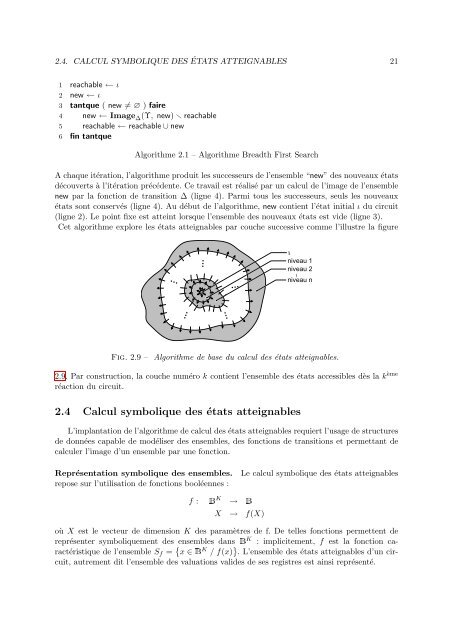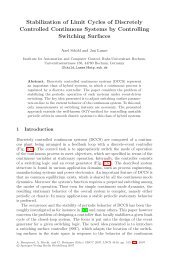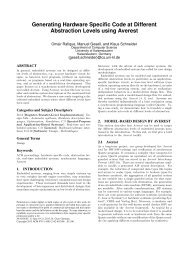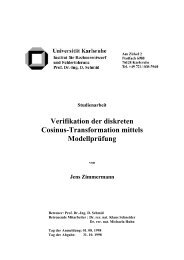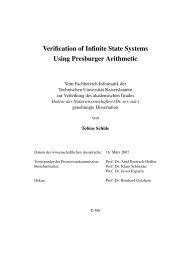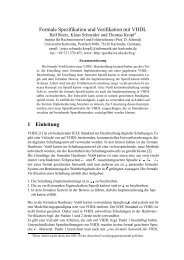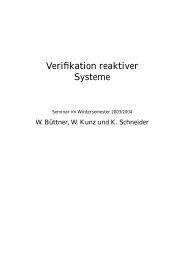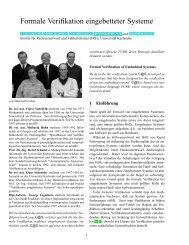Calcul des etats atteignables de programmes Esterel partitionne ...
Calcul des etats atteignables de programmes Esterel partitionne ...
Calcul des etats atteignables de programmes Esterel partitionne ...
- No tags were found...
You also want an ePaper? Increase the reach of your titles
YUMPU automatically turns print PDFs into web optimized ePapers that Google loves.
2.4. CALCUL SYMBOLIQUE DES ÉTATS ATTEIGNABLES 211 reachable ← ι2 new ← ι3 tantque ( new ≠ ∅ ) faire4 new ← Image ∆ (Υ, new) reachable5 reachable ← reachable ∪ new6 fin tantqueAlgorithme 2.1 – Algorithme Breadth First SearchA chaque itération, l’algorithme produit les successeurs <strong>de</strong> l’ensemble “new” <strong><strong>de</strong>s</strong> nouveaux étatsdécouverts à l’itération précé<strong>de</strong>nte. Ce travail est réalisé par un calcul <strong>de</strong> l’image <strong>de</strong> l’ensemblenew par la fonction <strong>de</strong> transition ∆ (ligne 4). Parmi tous les successeurs, seuls les nouveauxétats sont conservés (ligne 4). Au début <strong>de</strong> l’algorithme, new contient l’état initial ι du circuit(ligne 2). Le point fixe est atteint lorsque l’ensemble <strong><strong>de</strong>s</strong> nouveaux états est vi<strong>de</strong> (ligne 3).Cet algorithme explore les états <strong>atteignables</strong> par couche successive comme l’illustre la figureιniveau 1niveau 2.niveau nFig. 2.9 – Algorithme <strong>de</strong> base du calcul <strong><strong>de</strong>s</strong> états <strong>atteignables</strong>.2.9. Par construction, la couche numéro k contient l’ensemble <strong><strong>de</strong>s</strong> états accessibles dès la kèmeréaction du circuit.2.4 <strong>Calcul</strong> symbolique <strong><strong>de</strong>s</strong> états <strong>atteignables</strong>L’implantation <strong>de</strong> l’algorithme <strong>de</strong> calcul <strong><strong>de</strong>s</strong> états <strong>atteignables</strong> requiert l’usage <strong>de</strong> structures<strong>de</strong> données capable <strong>de</strong> modéliser <strong><strong>de</strong>s</strong> ensembles, <strong><strong>de</strong>s</strong> fonctions <strong>de</strong> transitions et permettant <strong>de</strong>calculer l’image d’un ensemble par une fonction.Représentation symbolique <strong><strong>de</strong>s</strong> ensembles.repose sur l’utilisation <strong>de</strong> fonctions booléennes :Le calcul symbolique <strong><strong>de</strong>s</strong> états <strong>atteignables</strong>f : B K → BX → f(X)où X est le vecteur <strong>de</strong> dimension K <strong><strong>de</strong>s</strong> paramètres <strong>de</strong> f. De telles fonctions permettent <strong>de</strong>représenter symboliquement <strong><strong>de</strong>s</strong> ensembles dans B K : implicitement, f est la fonction caractéristique<strong>de</strong> l’ensemble S f = { x ∈ B K / f(x) } . L’ensemble <strong><strong>de</strong>s</strong> états <strong>atteignables</strong> d’un circuit,autrement dit l’ensemble <strong><strong>de</strong>s</strong> valuations vali<strong><strong>de</strong>s</strong> <strong>de</strong> ses registres est ainsi représenté.


